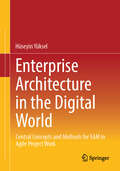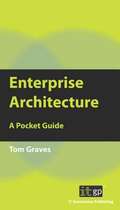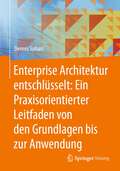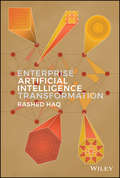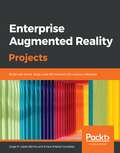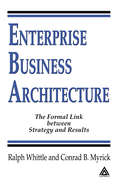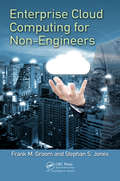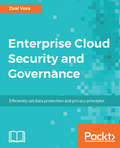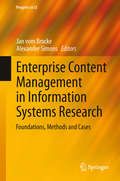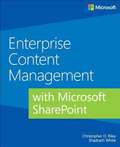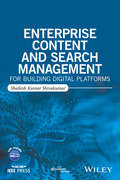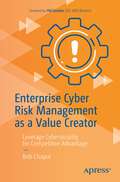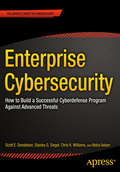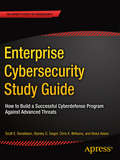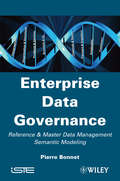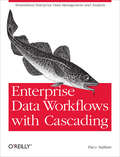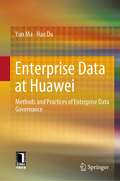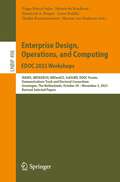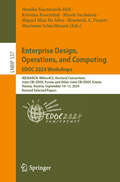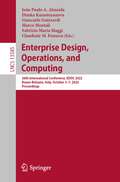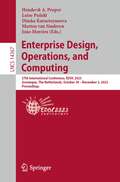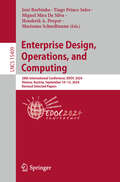- Table View
- List View
Enterprise Architecture in the Digital World: Central Concepts and Methods for EAM in Agile Project Work
by Hüseyin YükselHow do companies achieve the transformation into an agile, innovative, digital business and work environment? This question concerns not only IT managers but also strategic players, the enterprise architects. They must bridge the gap between strategic planning and dealing with increasing speed and growing uncertainty. Holistic enterprise development in the digital future means developing digital ecosystems and complex IT landscapes. This book presents methods and concepts from the agile world, semiotics, and neuropsychology that can help enterprise architects in their practical everyday work. Starting from a positive view of humanity, it is possible to harness the potential of individuals and teams for digital transformation with fundamental knowledge. The book is primarily aimed at IT managers, enterprise architects, and managers involved in large-scale software development processes. Many practical examples illustrate the theoretically presented connections and provide broader access to enterprise architecture management.
Enterprise Architecture: A Pocket Guide
by Tom GravesEnterprise architecture makes a vital contribution to the running of a large organisation. It was originally developed in order to manage a rapid growth in the cost and complexity of IT systems, using knowledge gained from software structure and design. For this reason, enterprise architecture is often thought of as a component of IT governance. However, the discipline has evolved and extended its scope. Enterprise architecture is now about structuring business capabilities and processes in order to support your long-term business strategy. Effective application of enterprise architecture will enable you to improve your productivity and performance. This pocket guide offers you an invaluable introduction to this business-critical subject. It explains the function of enterprise architecture within the organisation, looks at the skills needed within the enterprise architecture team and provides an overview of the most common enterprise architecture frameworks. As the author emphasises, enterprise architecture is not about creating models and designs for their own sake, but about using these structures to serve the needs of the business.
Enterprise Architektur entschlüsselt: Ein Praxisorientierter Leitfaden von den Grundlagen bis zur Anwendung
by Dennis SuhariEntdecken Sie "Enterprise Architektur entschlüsselt: Ein praxisorientierter Leitfaden von den Grundlagen bis zur Anwendung“ von Dennis Suhari, ein praxisorientiertes Werk, das die Förderung des Bewusstseins für Enterprise Architektur, die Vermittlung praktischer Erfahrungen und die Unterstützung der Leser bei der erfolgreichen Anwendung ihres Wissens in den Mittelpunkt stellt. Ein Schlüsselelement dieses Buches ist das praxisnahe Fallbeispiel, das einen einzigartigen Einblick in den Aufbau einer Enterprise Architektur von der Geschäfts- über die IT Architektur von Grund auf bietet.Was Sie erwartet:Fundamentale Grundlagen: Ein tiefgreifender Einblick in die essenziellen Grundlagen der Unternehmensarchitektur, um Schlüsselkonzepte und Prinzipien zu vermitteln, die als robuste Basis für die weitere Entwicklung dienen.Modellierung und praktische Tools: Entdecken Sie vielfältige Modellierungsmöglichkeiten und EAM-Tools, die inder Praxis zur Unterstützung der Architekturentwicklung eingesetzt werden.Architekturentwicklung in der Praxis: Anhand des Fallbeispiels der fiktiven Micayu GmbH, basierend auf den umfangreichen Erfahrungen des Autors, erleben Sie die Schritte der Entwicklung einer Unternehmensarchitektur von Grund auf.Zukunftsperspektiven: Ein Ausblick auf die Rolle der Künstlichen Intelligenz und dessen Einfluss auf das Enterprise Architektur Management
Enterprise Artificial Intelligence Transformation
by Rashed HaqEnterprise Artificial Intelligence Transformation AI is everywhere. From doctor's offices to cars and even refrigerators, AI technology is quickly infiltrating our daily lives. AI has the ability to transform simple tasks into technological feats at a human level. This will change the world, plain and simple. That's why AI mastery is such a sought-after skill for tech professionals. Author Rashed Haq is a subject matter expert on AI, having developed AI and data science strategies, platforms, and applications for Publicis Sapient's clients for over 10 years. He shares that expertise in the new book, Enterprise Artificial Intelligence Transformation. The first of its kind, this book grants technology leaders the insight to create and scale their AI capabilities and bring their companies into the new generation of technology. As AI continues to grow into a necessary feature for many businesses, more and more leaders are interested in harnessing the technology within their own organizations. In this new book, leaders will learn to master AI fundamentals, grow their career opportunities, and gain confidence in machine learning. Enterprise Artificial Intelligence Transformation covers a wide range of topics, including: Real-world AI use cases and examples Machine learning, deep learning, and slimantic modeling Risk management of AI models AI strategies for development and expansion AI Center of Excellence creating and management If you're an industry, business, or technology professional that wants to attain the skills needed to grow your machine learning capabilities and effectively scale the work you're already doing, you'll find what you need in Enterprise Artificial Intelligence Transformation.
Enterprise Augmented Reality Projects: Build real-world, large-scale AR solutions for various industries
by Jorge R. Benito Enara Artetxe GonzalezDesign end-to-end AR solutions for domains such as marketing, retail, manufacturing, tourism, automation, and training Key Features Use leading AR development frameworks such as ARCore, ARKit, and Vuforia across key industries Identify the market potential of AR for designing visual solutions in different business sectors Build multi-platform AR projects for various platforms such as Unity, iOS, and Android Book Description Augmented reality (AR) is expanding its scope from just being used in mobile and game applications to enterprise. Different industries are using AR to enhance assembly line visualization, guide operators performing difficult tasks, attract more customers, and even improve training techniques. In this book, you'll gain comprehensive insights into different aspects of developing AR-based apps for six different enterprise sectors, focusing on market needs and choosing the most suitable tool in each case. You'll delve into the basics of Unity and get familiar with Unity assets, materials, and resources, which will help you build a strong foundation for working on the different AR projects covered in the book. You'll build real-world projects for various industries such as marketing, retail, and automation in a step-by-step manner. This will give you hands-on experience in developing your own industrial AR apps. While building the projects, you'll explore various AR frameworks used in the enterprise environment such as Vuforia, EasyAR, ARCore, and ARKit, and understand how they can be used by themselves or integrated into the Unity 3D engine to create AR markers, 3D models, and components of an AR app. By the end of this book, you'll be well versed in using different commercial AR frameworks as well as Unity for building robust AR projects. What you will learn Understand the basics of Unity application development and C# scripting Learn how to use Android Studio along with ARCore and Sceneform to build AR prototypes for Android devices Enable AR experiences on the web with ARCore and WebAR Explore emerging AR authoring tools such as Augmented Class! for education Understand the differences and similarities between handheld and head-mounted display (HMD) environments and how to build an app for each target Become well versed in using Xcode with ARKit and SceneKit to develop AR portals for iOS devices Who this book is for This book is for anyone interested in emerging and interactive technologies or looking to build AR applications for any domain. Although, no prior augmented reality experience is required, having some skills in object-oriented programming (OOP) will be helpful.
Enterprise Business Architecture: The Formal Link between Strategy and Results
by Ralph Whittle Conrad B. MyrickA critical part of any company's successful strategic planning is the creation of an Enterprise Business Architecture (EBA) with its formal linkages. Strategic research and analysis firms have recognized the importance of an integrated enterprise architecture and they have frequently reported on its increasing value to successful companies. Enterpr
Enterprise Cloud Computing
by Gautam ShroffCloud computing promises to revolutionize IT and business by making computing available as a utility over the internet. This book is intended primarily for practising software architects who need to assess the impact of such a transformation. It explains the evolution of the internet into a cloud computing platform, describes emerging development paradigms and technologies, and discusses how these will change the way enterprise applications should be architected for cloud deployment. Gautam Shroff provides a technical description of cloud computing technologies, covering cloud infrastructure and platform services, programming paradigms such as MapReduce, as well as 'do-it-yourself' hosted development tools. He also describes emerging technologies critical to cloud computing. The book also covers the fundamentals of enterprise computing, including a technical introduction to enterprise architecture, so it will interest programmers aspiring to become software architects and serve as a reference for a graduate-level course in software architecture or software engineering.
Enterprise Cloud Computing for Non-Engineers (Technology for Non-Engineers)
by Stephan Jones Frank GroomThis book provides a technical description of cloud computing technologies, covering cloud infrastructure and platform services. It then addresses the basics of operating a Cloud computing data center, the services offered from Cloud providers, the carrier role in connecting users to data centers, and the process of interconnecting Cloud data centers to form a flexible processing unit. It also describes how cloud computing has made an impact in various industries and provides emerging technologies that are critical within each industry. Lastly, this book will address security requirements and provide the best practices in securing data.
Enterprise Cloud Security and Governance: Efficiently set data protection and privacy principles
by Adrian Pruteanu Zeal VoraKey Features Gain a firm grasp of Cloud data security and governance, irrespective of your Cloud platform Practical examples to ensure you secure your Cloud environment efficiently A step-by-step guide that will teach you the unique techniques and methodologies of Cloud data governance Book Description Modern day businesses and enterprises are moving to the Cloud, to improve efficiency and speed, achieve flexibility and cost effectiveness, and for on-demand Cloud services. However, enterprise Cloud security remains a major concern because migrating to the public Cloud requires transferring some control over organizational assets to the Cloud provider. There are chances these assets can be mismanaged and therefore, as a Cloud security professional, you need to be armed with techniques to help businesses minimize the risks and misuse of business data. The book starts with the basics of Cloud security and offers an understanding of various policies, governance, and compliance challenges in Cloud. This helps you build a strong foundation before you dive deep into understanding what it takes to design a secured network infrastructure and a well-architected application using various security services in the Cloud environment. Automating security tasks, such as Server Hardening with Ansible, and other automation services, such as Monit, will monitor other security daemons and take the necessary action in case these security daemons are stopped maliciously. In short, this book has everything you need to secure your Cloud environment with. It is your ticket to obtain industry-adopted best practices for developing a secure, highly available, and fault-tolerant architecture for organizations. What you will learn Configure your firewall and Network ACL Protect your system against DDOS and application-level attacks Explore cryptography and data security for your cloud Get to grips with configuration management tools to automate your security tasks Perform vulnerability scanning with the help of the standard tools in the industry Learn about central log management
Enterprise Content Management in Information Systems Research
by Jan Vom Brocke Alexander SimonsThis book collects ECM research from the academic discipline of Information Systems and related fields to support academics and practitioners who are interested in understanding the design, use and impact of ECM systems. It also provides a valuable resource for students and lecturers in the field. "Enterprise content management in Information Systems research - Foundations, methods and cases" consolidates our current knowledge on how today's organizations can manage their digital information assets. The business challenges related to organizational information management include reducing search times, maintaining information quality, and complying with reporting obligations and standards. Many of these challenges are well-known in information management, but because of the vast quantities of information being generated today, they are more difficult to deal with than ever. Many companies use the term "enterprise content management" (ECM) to refer to the management of all forms of information, especially unstructured information. While ECM systems promise to increase and maintain information quality, to streamline content-related business processes, and to track the lifecycle of information, their implementation poses several questions and challenges: Which content objects should be put under the control of the ECM system? Which processes are affected by the implementation? How should outdated technology be replaced? Research is challenged to support practitioners in answering these questions.
Enterprise Content Management with Microsoft SharePoint
by Christopher D. Riley Shadrach White<p>Meet the challenges of Enterprise Content Management (ECM) head on, using rich ECM features in Microsoft SharePoint 2013. Led by two ECM experts, you’ll learn how to build a solid information architecture (IA) for managing documents, knowledge, web content, digital assets, records, and user-generated content throughout your organization. Examples and case studies are based on the authors’ real-world experience.</p>
Enterprise Content and Search Management for Building Digital Platforms
by Shailesh Kumar ShivakumarProvides modern enterprises with the tools to create a robust digital platform utilizing proven best practices, practical models, and time-tested techniques Contemporary business organizations can either embrace the digital revolution—or be left behind. Enterprise Content and Search Management for Building Digital Platforms provides modern enterprises with the necessary tools to create a robust digital platform utilizing proven best practices, practical models, and time-tested techniques to compete in the today’s digital world. Features include comprehensive discussions on content strategy, content key performance indicators (KPIs), mobile-first strategy, content assessment models, various practical techniques and methodologies successfully used in real-world digital programs, relevant case studies, and more. Initial chapters cover core concepts of a content management system (CMS), including content strategy; CMS architecture, templates, and workflow; reference architectures, information architecture, taxonomy, and content metadata. Advanced CMS topics are then covered, with chapters on integration, content standards, digital asset management (DAM), document management, and content migration, evaluation, validation, maintenance, analytics, SEO, security, infrastructure, and performance. The basics of enterprise search technologies are explored next, and address enterprise search architecture, advanced search, operations, and governance. Final chapters then focus on enterprise program management and feature coverage of various concepts of digital program management and best practices—along with an illuminating end-to-end digital program case study. Comprehensive and cutting-edge, Enterprise Content and Search Management for Building Digital Platforms is an invaluable reference resource for creating an optimal enterprise digital eco-system to meet the challenges of today’s hyper-connected world.
Enterprise Cyber Risk Management as a Value Creator: Leverage Cybersecurity for Competitive Advantage
by Bob ChaputThis book will help you learn the importance of organizations treating enterprise cyber risk management (ECRM) as a value creator, a business enabler, and a mechanism to create a competitive advantage. Organizations began to see the real value of information and information technology in the mid-1980s. Forty years later, it’s time to leverage your ECRM program and cybersecurity strategy in the same way. The main topics covered include the case for action with specific coverage on the topic of cybersecurity as a value creator, including how the courts, legislators, and regulators are raising the bar for C-suite executives and board members. The book covers how the board’s three primary responsibilities (talent management, strategy, and risk management) intersect with their ECRM responsibilities.ECRM was once solely focused on managing the downside of risk by defending the organization from adversarial, accidental, structural, and environmental threat sources. Author Bob Chaput presents the view that we must focus equally on managing the upside of cyber strengths to increase customer trust and brand loyalty, improving social responsibility, driving revenue growth, lowering the cost of capital, attracting higher quality investments, creating competitive advantage, attracting and retaining talent, and facilitating M&A work. He focuses on the C-suite and board role in the first part and provides guidance on their roles and responsibilities, the most important decision about ECRM they must facilitate, and how to think differently about ECRM funding. You will learn how to the pivot from cost-center thinking to value-center thinking.Having built the case for action, in the second part, the book details the steps that organizations must take to develop and document their ECRM program and cybersecurity strategy. The book first covers how ECRM must be integrated into business strategy. The remainder of that part presents a sample table of contents for an ECRM Program and Cybersecurity Strategy document and works through each section to facilitate development of your own program and strategy. With all the content and ideas presented, you will be able to establish, implement, and mature your program and strategy.What You Will LearnRead new information and treat ECRM and cybersecurity as a value creatorReceive updates on legal cases, legislative actions, and regulations that are raising the stakes for organizations, their C-suites, and boardsThink differently about funding ECRM and cybersecurity initiativesUnderstand the most critical ECRM decision that boards must facilitate in their organizationsUse practical, tangible, actionable content to develop and document your ECRM program and cybersecurity strategy“This book should be mandatory reading for C-suite executives and board members. It shows you how to move from viewing cybersecurity as a risk to avoid, and a cost center that does not add value and is overhead, to seeing cybersecurity as an enabler and part of your core strategy to transform your business and earn customer and stakeholder trust.” —Paul Connelly, First CISO at the White House and HCA Healthcare Who This Book Is ForThe primary audience includes Chief Information Security Officers, Chief Risk Officers, and Chief Compliance Officers. The secondary audience includes C-suite executives and board members. The tertiary audience includes any stakeholder responsible for privacy, security, compliance, and cyber risk management or students of these topics.
Enterprise Cybersecurity
by Scott E. Donaldson Stanley G. Siegel Chris K. Williams Abdul AslamUnify your organization''s people, budgets, technologies, and processes into a cost-efficient cybersecurity program capable of countering advanced cyberattacks and containing damage in the event of a breach. Enterprise Cybersecurity empowers organizations of all sizes to defend themselves with next-generation cybersecurity programs against the escalating threat of modern targeted cyberattacks. Enterprise Cybersecurity presents a comprehensive framework for managing all aspects of an enterprise cybersecurity program. It enables an enterprise to architect, design, implement, and operate a coherent cybersecurity program that is seamlessly coordinated with policy, programmatics, IT life cycle, and assessment. Fail-safe cyberdefense is a pipe dream. Given sufficient time, an intelligent attacker can eventually defeat defensive measures protecting an enterprise''s computer systems and IT networks. To prevail, an enterprise cybersecurity program must manage risk by detecting attacks early enough and delaying them long enough that the defenders have time to respond effectively. The authors of Enterprise Cybersecurity explain at both strategic and tactical levels how to accomplish the mission of leading, designing, deploying, operating, managing, and supporting cybersecurity capabilities in an enterprise environment. The authors are recognized experts and thought leaders in this rapidly evolving field, drawing on decades of collective experience in cybersecurity and IT. In capacities ranging from executive strategist to systems architect to cybercombatant, Scott E. Donaldson, Stanley G. Siegel, Chris K. Williams, and Abdul Aslam have fought on the front lines of cybersecurity against advanced persistent threats to government, military, and business entities. What you''ll learn Executives, managers, architects, IT professionals, customers and vendors of cybersecurity services, and engineering students will learn from this book How to create a data-driven and objectively-managed cybersecurity program optimally tailored to your organization How to organize, assess, and score cybersecurity programs using the authors'' enterprise cybersecurity architecture scheme The methodology of targeted attacks and why they succeed The processes of cybersecurity risk management, capability assessment, scope selection, operations, and supporting information systems How to audit and report your cybersecurity program in compliance with regulatory frameworks How cybersecurity is evolving and projected to evolve Who this book is for Enterprise Cybersecurity is for people and organizations interested in modern cybersecurity and who are responsible for leading, designing, deploying, operating, managing, and supporting cybersecurity capabilities in an enterprise environment. Table of Contents Part I: The Cybersecurity Challenge Chapter 1: Defining the Cybersecurity Challenge Chapter 2: Meeting the Cybersecurity Challenge Part II: A New Enterprise Cybersecurity Architecture Chapter 3: Enterprise Cybersecurity Architecture Chapter 4: Implementing Enterprise Cybersecurity Chapter 5: Operating Enterprise Cybersecurity Chapter 6: Enterprise Cybersecurity and the Cloud Chapter 7: Enterprise Cybersecurity for Mobile and BYOD Part III: The Art of Cyberdefense Chapter 8: Building an Effective Defense Chapter 9: Responding to Incidents Chapter 10: Managing a Cybersecurity Crisis Part IV: Enterprise Cyberdefense Assessment Chapter 11: Assessing Enterprise Cybersecurity Chapter 12: Measuring a Cybersecurity Program Chapter 13: Mapping Against Cybersecurity Frameworks Part V: Enterprise Cybersecurity Program Chapter 14: Managing an Enterprise Cybersecurity Program Chapter 15: Looking to the Future Appendices: Appendix A: Common Cyberattacks Appendix B: Cybersecurity Frameworks Appendix C: Enterprise Cybersecurity Capabilities Appendix D: Sample Cybersecurity Policy Appendix E: Cybersecurity Operational Processes Appendix F: Object Measurement Appendix G: Cybersecurity Capability Value Scales Appendix H: Cybersecurity Sample Assessment Appendix I: Net...
Enterprise Cybersecurity Study Guide: How To Build A Successful Cyberdefense Program Against Advanced Threats
by Scott E. Donaldson Stanley G. Siegel Chris K. Williams Abdul AslamUse the methodology in this study guide to design, manage, and operate a balanced enterprise cybersecurity program that is pragmatic and realistic in the face of resource constraints and other real-world limitations. This guide is an instructional companion to the book Enterprise Cybersecurity: How to Build a Successful Cyberdefense Program Against Advanced Threats. The study guide will help you understand the book’s ideas and put them to work. The guide can be used for self-study or in the classroom.Enterprise cybersecurity is about implementing a cyberdefense program that will succeed in defending against real-world attacks. While we often know what should be done, the resources to do it often are not sufficient. The reality is that the Cybersecurity Conundrum—what the defenders request, what the frameworks specify, and what the budget allows versus what the attackers exploit—gets in the way of what needs to be done. Cyberattacks in the headlines affecting millions of people show that this conundrum fails more often than we would prefer.Cybersecurity professionals want to implement more than what control frameworks specify, and more than what the budget allows. Ironically, another challenge is that even when defenders get everything that they want, clever attackers are extremely effective at finding and exploiting the gaps in those defenses, regardless of their comprehensiveness. Therefore, the cybersecurity challenge is to spend the available budget on the right protections, so that real-world attacks can be thwarted without breaking the bank.People involved in or interested in successful enterprise cybersecurity can use this study guide to gain insight into a comprehensive framework for coordinating an entire enterprise cyberdefense program.What You’ll Learn Know the methodology of targeted attacks and why they succeed Master the cybersecurity risk management process Understand why cybersecurity capabilities are the foundation of effective cyberdefenses Organize a cybersecurity program's policy, people, budget, technology, and assessment Assess and score a cybersecurity program Report cybersecurity program status against compliance and regulatory frameworks Use the operational processes and supporting information systems of a successful cybersecurity program Create a data-driven and objectively managed cybersecurity program Discover how cybersecurity is evolving and will continue to evolve over the next decade Who This Book Is For Those involved in or interested in successful enterprise cybersecurity (e.g., business professionals, IT professionals, cybersecurity professionals, and students). This guide can be used in a self-study mode. The book can be used by students to facilitate note-taking in the classroom and by Instructors to develop classroom presentations based on the contents of the original book, Enterprise Cybersecurity: How to Build a Successful Cyberdefense Program Against Advanced Threats.
Enterprise Cybersecurity in Digital Business: Building a Cyber Resilient Organization
by Ariel EvansCyber risk is the highest perceived business risk according to risk managers and corporate insurance experts. Cybersecurity typically is viewed as the boogeyman: it strikes fear into the hearts of non-technical employees. Enterprise Cybersecurity in Digital Business: Building a Cyber Resilient Organization provides a clear guide for companies to understand cyber from a business perspective rather than a technical perspective, and to build resilience for their business. Written by a world-renowned expert in the field, the book is based on three years of research with the Fortune 1000 and cyber insurance industry carriers, reinsurers, and brokers. It acts as a roadmap to understand cybersecurity maturity, set goals to increase resiliency, create new roles to fill business gaps related to cybersecurity, and make cyber inclusive for everyone in the business. It is unique since it provides strategies and learnings that have shown to lower risk and demystify cyber for each person. With a clear structure covering the key areas of the Evolution of Cybersecurity, Cybersecurity Basics, Cybersecurity Tools, Cybersecurity Regulation, Cybersecurity Incident Response, Forensics and Audit, GDPR, Cybersecurity Insurance, Cybersecurity Risk Management, Cybersecurity Risk Management Strategy, and Vendor Risk Management Strategy, the book provides a guide for professionals as well as a key text for students studying this field. The book is essential reading for CEOs, Chief Information Security Officers, Data Protection Officers, Compliance Managers, and other cyber stakeholders, who are looking to get up to speed with the issues surrounding cybersecurity and how they can respond. It is also a strong textbook for postgraduate and executive education students in cybersecurity as it relates to business.
Enterprise Data Governance: Reference and Master Data Management Semantic Modeling
by Pierre BonnetIn an increasingly digital economy, mastering the quality of data is an increasingly vital yet still, in most organizations, a considerable task. The necessity of better governance and reinforcement of international rules and regulatory or oversight structures (Sarbanes Oxley, Basel II, Solvency II, IAS-IFRS, etc.) imposes on enterprises the need for greater transparency and better traceability of their data. All the stakeholders in a company have a role to play and great benefit to derive from the overall goals here, but will invariably turn towards their IT department in search of the answers. However, the majority of IT systems that have been developed within businesses are overly complex, badly adapted, and in many cases obsolete; these systems have often become a source of data or process fragility for the business. It is in this context that the management of ‘reference and master data’ or Master Data Management (MDM) and semantic modeling can intervene in order to straighten out the management of data in a forward-looking and sustainable manner. This book shows how company executives and IT managers can take these new challenges, as well as the advantages of using reference and master data management, into account in answering questions such as: Which data governance functions are available? How can IT be better aligned with business regulations? What is the return on investment? How can we assess intangible IT assets and data? What are the principles of semantic modeling? What is the MDM technical architecture? In these ways they will be better able to deliver on their responsibilities to their organizations, and position them for growth and robust data management and integrity in the future.
Enterprise Data Workflows with Cascading: Streamlined Enterprise Data Management and Analysis
by Paco NathanThere is an easier way to build Hadoop applications. With this hands-on book, you’ll learn how to use Cascading, the open source abstraction framework for Hadoop that lets you easily create and manage powerful enterprise-grade data processing applications—without having to learn the intricacies of MapReduce.Working with sample apps based on Java and other JVM languages, you’ll quickly learn Cascading’s streamlined approach to data processing, data filtering, and workflow optimization. This book demonstrates how this framework can help your business extract meaningful information from large amounts of distributed data.Start working on Cascading example projects right awayModel and analyze unstructured data in any format, from any sourceBuild and test applications with familiar constructs and reusable componentsWork with the Scalding and Cascalog Domain-Specific LanguagesEasily deploy applications to Hadoop, regardless of cluster location or data sizeBuild workflows that integrate several big data frameworks and processesExplore common use cases for Cascading, including features and tools that support themExamine a case study that uses a dataset from the Open Data Initiative
Enterprise Data at Huawei: Methods and Practices of Enterprise Data Governance
by Yun Ma Hao DuThis book systematically introduces the data governance and digital transformation at Huawei, from the perspectives of technology, process, management, and so on. Huawei is a large global enterprise engaging in multiple types of business in over 170 countries and regions. Its differentiated operation is supported by an enterprise data foundation and corresponding data governance methods. With valuable experience, methodology, standards, solutions, and case studies on data governance and digital transformation, enterprise data at Huawei is ideal for readers to learn and apply, as well as to get an idea of the digital transformation journey at Huawei. This book is organized into four parts and ten chapters. Based on the understanding of “the cognitive world of machines,” the book proposes the prospects for the future of data governance, as well as the imaginations about AI-based governance, data sovereignty, and building a data ecosystem.
Enterprise Design, Operations, and Computing. EDOC 2022 Workshops: IDAMS, SoEA4EE, TEAR, EDOC Forum, Demonstrations Track and Doctoral Consortium, Bozen-Bolzano, Italy, October 4–7, 2022, Revised Selected Papers (Lecture Notes in Business Information Processing #466)
by Giancarlo Guizzardi Marco Montali Henderik A. Proper Fabrizio Maria Maggi Claudenir M. Fonseca Tiago Prince SalesThis book constitutes revised selected papers from the international workshops, the EDOC Forum and the Demonstration and Doctoral Consortium track, that were held at the 26th International Conference on Enterprise Design, Operations, and Computing, EDOC 2022. The conference took place in Bozen-Bolzano, Italy, during October 3–7, 2022.The conference focuses on the area of enterprise computing, this year with the special emphasis on the theme of designing and operating “Flexible Enterprises”. Workshops within EDOC cover more focused topics and allow for the presentation and discussion of work that is in the earlier development stages. The 18 full and 8 short papers included in this volume were carefully reviewed and selected from 82 submissions. They stem from the following satellite events: – Workshop on Intelligent Digital Architecture, Methods, and Services for Industry 4.0 and Society 5.0 (IDAMS) – 14th Workshop on Service-oriented Enterprise Architecture for Enterprise Engineering (SoEA4EE) – 17th Workshop on Trends in Enterprise Architecture Research (TEAR) – EDOC Forum – Demonstrations Track – Doctoral Consortium
Enterprise Design, Operations, and Computing. EDOC 2023 Workshops: IDAMS, iRESEARCH, MIDas4CS, SoEA4EE, EDOC Forum, Demonstrations Track and Doctoral Consortium, Groningen, The Netherlands, October 30–November 3, 2023, Revised Selected Papers (Lecture Notes in Business Information Processing #498)
by Marten Van Sinderen Henderik A. Proper Sybren De Kinderen Dimka Karastoyanova Tiago Prince Sales Luise PufahlThis volume constitutes revised selected papers of several workshops, the EDOC Forum and the Demonstrations and Doctoral Consortium track, which were held in conjunction with the 27th International Conference on Enterprise Design, Operations, and Computing, EDOC 2023, in Groningen, The Netherlands, during October 30–November 3, 2023. The 18 revised full papers and 7 short papers presented in this book were carefully reviewed and selected from 37 submissions. They stem from the following satellite events: - Workshop on Intelligent Digital Architecture, Methods, and Services for Industry 4.0 and Society 5.0 (IDAMS)- Workshop on Empirical Methodologies for Research in Enterprise Architecture and Service-Oriented Computing (iRESEARCH)- Workshop on the Modelling and Implementation of Digital Twins for Complex Systems (MIDas4CS)- Workshop on Service-oriented Enterprise Architecture for Enterprise Engineering (SoEA4EE)- EDOC Forum- Demonstrations Track- Doctoral Consortium
Enterprise Design, Operations, and Computing. EDOC 2024 Workshops: iRESEARCH, MIDas4CS, Doctoral Consortium, Joint CBI–EDOC Forum and Other Joint CBI-EDOC Events, Vienna, Austria, September 10–13, 2024, Revised Selected Papers (Lecture Notes in Business Information Processing #537)
by Henderik A. Proper Monika Kaczmarek-Heß Marianne Schnellmann Kristina Rosenthal Marek Suchánek Miguel Mira Da SilvaThis volume constitutes revised selected papers of two workshops, the Doctoral Consortium, the Joint CBI-EDOC Forum and and other Joint CBI-EDOC event, which were held in conjunction with the 28th International Conference on Enterprise Design, Operations, and Computing, EDOC 2024, in Vienna, Austria, in September 10–13, 2024. The presented revised full papers in this book were carefully reviewed and selected. They stem from the following satellite events: iRESEARCH – 2nd International Workshop on Empirical Methodologies for Research in Enterprise Architecture and Service-oriented Computing MIDas4CS – 2nd Workshop on the Modelling and Implementation of Digital Twins for Complex Systems Joint CBI–EDOC Forum Joint CBI–EDOC Case Reports Track Joint CBI–EDOC Tools & Demos Track EDOC Doctoral Consortium CBI Mini Dagstuhl Seminars
Enterprise Design, Operations, and Computing: 26th International Conference, EDOC 2022, Bozen-Bolzano, Italy, October 3–7, 2022, Proceedings (Lecture Notes in Computer Science #13585)
by Giancarlo Guizzardi Marco Montali João Paulo A. Almeida Dimka Karastoyanova Fabrizio Maria Maggi Claudenir M. FonsecaThis book constitutes the proceedings of the 26th International Conference on Enterprise Design, Operations, and Computing, EDOC 2022, which took place in Bozen-Bolzano, Italy, in October 2022. The 15 full papers included in this book were carefully reviewed and selected from 48 submissions. They were organized in topical sections as follows: enterprise security; enterprise architecture; business process modeling and monitoring; business process mining and discovery; and process-driven applications.
Enterprise Design, Operations, and Computing: 27th International Conference, EDOC 2023, Groningen, The Netherlands, October 30 – November 3, 2023, Proceedings (Lecture Notes in Computer Science #14367)
by Marten Van Sinderen João Moreira Henderik A. Proper Dimka Karastoyanova Luise PufahlThis book constitutes the refereed proceedings of the 27th International Conference on Enterprise Design, Operations, and Computing, EDOC 2023, held in Groningen, The Netherlands, during October 30–November 3, 2023.The 12 full papers included in this book were carefully reviewed and selected from 36submissions. They were organized in topical sections as follows: Enterprise Modeling, Enterprise Architecture & Engineering, Model-Based Software Engineering, Enterprise Analysis with Process Mining, Process Improvement & Engineering, and Modeling in an Enterprise Context.
Enterprise Design, Operations, and Computing: 28th International Conference, EDOC 2024, Vienna, Austria, September 10–13, 2024, Revised Selected Papers (Lecture Notes in Computer Science #15409)
by Henderik A. Proper José Borbinha Tiago Prince Sales Marianne Schnellmann Miguel Mira Da SilvaThis book constitutes the refereed proceedings of the 28th International Conference on Enterprise Design, Operations, and Computing, EDOC 2024, held in Vienna, Austria, during September 10–13, 2024. The 18 full papers included in this book were carefully reviewed and selected from 70 submissions. They were organized in topical sections as follows: AI, ML and Agents; BPM and WFM; Business Models, Platforms and Strategic Management; Enterprise and IT Architecture; IT and Software Architecture; Modeling Methods, Data and Component; Process Mining and Monitoring; and Sustainability and Resilience.
